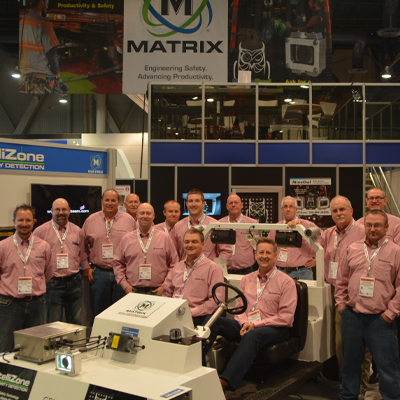
If Mine Expo 2020 Had Taken Place…
Matrix would have introduced its new and updated products and services
As seen in Coal Age Magazine
Had MINExpo 2020 taken place, attendees would have seen some the new features that Matrix has added to its equipment and some of the new equipment it has added to its product line.
“We have accomplished a lot in the last year as far as adding equipment to diversify our product lines,” said Brian Jones, vice president of Business Development for Matrix. “And, we have a couple of new features for the IntelliZone product that improves downtime, maintenance and overall operations.”
One of those new features is the IntelliZone Status Screen that gives the continuous miner operator or anyone on the system a quick reference as to what is happening inside the system.
“We launched this during August,” Jones said. “We have been testing it underground and we will be rolling it out during the next couple of months.”
Another new feature is the Machine-Mounted Locator (MML), which monitors the health of the system as far as drivers and antennae.
“Using that in conjunction with the Status Screen reinforces operational performance and decreases trouble-shooting and maintenance,” Jones said. “We also have a new, longer-range driver that extends the area of influence to 120- to 150-feet with accurate tracking of personnel locators. We will use these on faster moving machinery.”
Matrix recently announced some new divisions, and one is an equipment division that specializes in ancillary safety items, such as rock dusting, rescue chambers and other related products.
“We have a new dozer rescue kit that includes, amongst other items, an O2 bottle and scrubbers,” Jones said. “If a dozer were to become buried, the operator could convert the cab into a pseudo rescue chamber. The operator does not have to place anything in his mouth like he would with a self-contained, self-rescuer. He can communicate freely with the radio during rescue operations.”
The equipment division is also offering a new, large-capacity trickle duster. Instead of refilling the rock duster every four hours, miners can spread rock dust for 12 or 15 hours before they need to refill the tank.
Matrix recently acquired a South African analytics firm and formed Matrix Analytics.
“We are in the process of integrating analytics features into our product lines,” Jones said. “Analytics is a powerful tool that can be used to make decisions that improve productivity, and we’re scaling that up now.”
Partnering with APS, Matrix has also branched out into lighting. APS has a robust lighting product line that includes LEDs for area lighting and machine lighting. Mine owners can now replace the metal halide lights found at various locations around the operation with LEDs.
“These lights have a terrific return on investment,” Jones said. “The payback can be months, and we offer a 5-year warranty.”
Jones said they have a safety-oriented light, UVision, for haulage that combines safe ultraviolet (UV) light with LED, making reflective material pop. “UV better illuminates reflective material, especially for peripheral vision,” he said.
Matrix is starting to distribute M5, a new methane monitoring system for continuous miners and roof bolters. They are distributing it on behalf of Monitech, a South African company that distributes the IntelliZone for Matrix in South Africa. In South Africa, Monitech has 90% to 95% market share.
“We now have approval from the Mine Safety and Health Administration (MSHA) for those methane monitors, and we have had trials running in production for a couple months now,” Jones said. “These devices will help coal operators recover the downtime associated with recalibrating methane monitors. There are, of course, fines levied when MSHA cites a methane monitor, but the downtime is usually more costly. The Monitech system does not have the same drift in calibration, which can alleviate these issues.”
Partnering with Maestro in Sudbury, Ontario, Canada, Matrix is bringing its Plexus PowerNet system to mines in the U.S. Plexus is a coaxial-based gigabit network that delivers data and power over a single cable.
“This is applicable for smaller mines that do not have the tools required to terminate fiber or larger mines that have an outby fiber backbone,” Jones said. “The operators are looking for connectivity for data and devices, such as IP cameras, but they would rather not run fiber into the working sections due to maintenance issues.”
